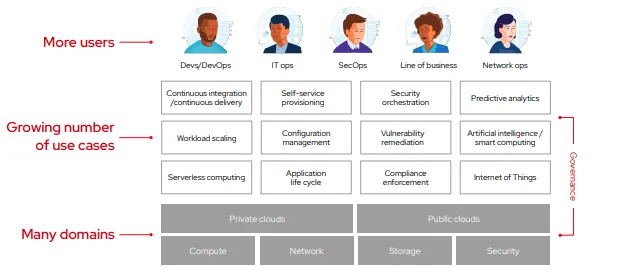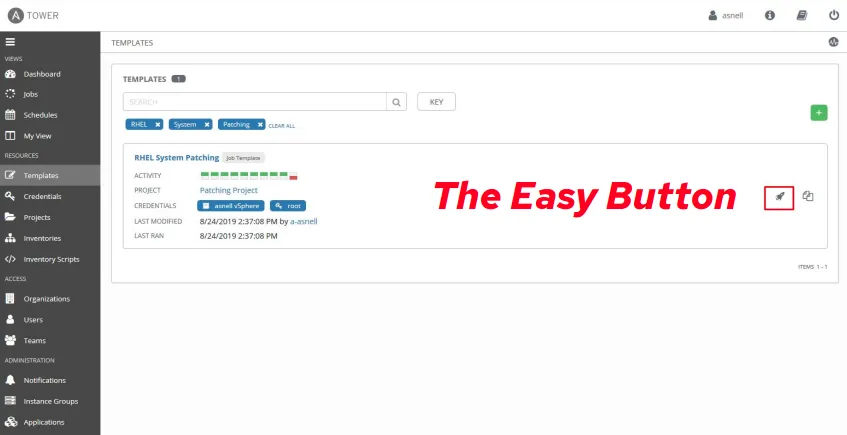In this post:
-
Learn about the unique challenges teams face in today's IT
-
The negative effects of cultural silos
-
How Ansible reinforces a culture of collaboration
In any large organization, you will need cross-functional teams to build and sustain your enterprise IT environment.
Large organizations often have teams that are isolated from one another, creating a silo that inhibits collaboration. Each silo may also have its own culture, which can make working across teams tricky. Collaboration in such a workplace might look more like just throwing something over the fence and letting someone do their part.
To succeed, it’s clear that businesses need to be able to work as one to move the ball forward.
How do you begin addressing these cultural challenges? We talked about some of the ways to address these in our Red Hat Summit breakout session titled “Ansible is the language of love: Breaking down cultural silos with automation.” We’ll cover the session’s highlights in this post.
Challenges: too many unintegrated, domain-specific tools
Today's IT is, or should be, a collaboration between operations, developers, InfoSec, and stakeholders across the business. These days, as businesses depend more and more on applications, a lot of line of business (LOB) users are directly touching technology as well.
We expect technology to do more, faster and we need to apply business logic and policies across the business with minimal human intervention. We want to empower users with self-service apps and computing resources. We need to manage more devices than ever, including Internet of Things (IoT) devices at the edge of our networks. We want to offer developers "serverless" technologies so they can focus solely on the application without worrying about infrastructure. The list goes on.
 These use cases are spread across public, private, and hybrid clouds as well as on-premise computing, on-premise network, on-premise storage, and so on.
These use cases are spread across public, private, and hybrid clouds as well as on-premise computing, on-premise network, on-premise storage, and so on.
Lastly, we need to think about governance. In other words, how do we use and safeguard data? Who has access to the data, and who can manage systems?
With all of these moving parts, the bottom line is that the ability to work together and cross-communicate is more important than ever.
Success = Humanity + Process + Technology
The key to overcoming cultural silos during your digital transformation is in the simple combination of humanity, process, and technology.
We define humanity as finding ways to build community and using people skills to analyze conflict and find points of agreement.
Empathy, compassion, community, and leadership are all important principles to help promote humanity in the workplace.
We show good empathy, for example, when we put ourselves in a coworker's shoes before getting angry or upset at them for something possibly outside their control, and compassion when we’re motivated to relieve their pain.
Community is all about recognizing that we work in a connected environment with connected outcomes—if people think badly about one team, they think badly about the whole community.
Finally, good leadership is using our influence to help move things forward, rather than going against or stonewalling different teams.
Process, on the other hand, is adopting modern practices and open principles to address priorities. There are four pillars of process:
-
Agile is a set of values and principles that place the focus on human-centric actions.
-
Automation creates mechanisms to do mundane, repetitive, or complicated tasks automatically and/or on demand.
-
DevOps is a set of practices that efficiently moves code through its life cycle.
-
Abstraction hides the details of the how, but allows you to benefit from the outcome.
Lastly, we want to implement automation technology that both supports and reinforces the culture, while providing the appropriate ROI.
This is where Ansible comes in.
Ansible and overcoming cultural silos
Red Hat Ansible Automation Platform reinforces a culture of collaboration by allowing you to automate things in a way that makes it easy for groups to interact, solve problems, and get stuff done.
It does this through the help of Ansible playbooks, blueprints of automation tasks that help IT staff program applications, services, server nodes, or other devices without the manual overhead of creating everything from scratch.
Once one person on your team learns how to do something, they can capture their solution in a playbook and enable everyone to use it.

For example, let’s say that only the Infrastructure team has the permissions to perform a patching update, but would like to set up permissions and create an “easy button” for the AppDev team to perform the patch as well.
To do this, Infrastructure generates a simple Ansible playbook. All the AppDev team has to do now is log in to Ansible Tower and press the rocket pictured below.
That is all!
Ansible Automation Platform can help to renew your IT culture
One of the biggest challenges of a digital transformation is that there are so many unintegrated, domain-specific tools. All of this complexity can lead to teams forming in silos, making it difficult to work together and cross-communicate.
We looked at how humanity + process + technology help foster an open and collaborative work environment, as well as how Ansible Automation Platform makes it possible for users across an organization to share, vet, and manage automation content.
You can watch the Summit breakout session on demand here through May 2022. Learn more about Red Hat Ansible Automation Platform here.
À propos des auteurs
Plus de résultats similaires
Red Hat Ansible Automation Platform: Measuring Business Impact with Dashboard and Analytics
Friday Five — December 5, 2025 | Red Hat
Technically Speaking | Platform engineering for AI agents
Technically Speaking | Driving healthcare discoveries with AI
Parcourir par canal
Automatisation
Les dernières nouveautés en matière d'automatisation informatique pour les technologies, les équipes et les environnements
Intelligence artificielle
Actualité sur les plateformes qui permettent aux clients d'exécuter des charges de travail d'IA sur tout type d'environnement
Cloud hybride ouvert
Découvrez comment créer un avenir flexible grâce au cloud hybride
Sécurité
Les dernières actualités sur la façon dont nous réduisons les risques dans tous les environnements et technologies
Edge computing
Actualité sur les plateformes qui simplifient les opérations en périphérie
Infrastructure
Les dernières nouveautés sur la plateforme Linux d'entreprise leader au monde
Applications
À l’intérieur de nos solutions aux défis d’application les plus difficiles
Virtualisation
L'avenir de la virtualisation d'entreprise pour vos charges de travail sur site ou sur le cloud
